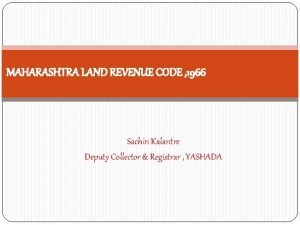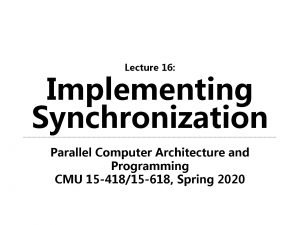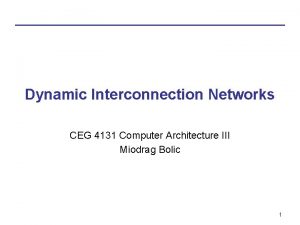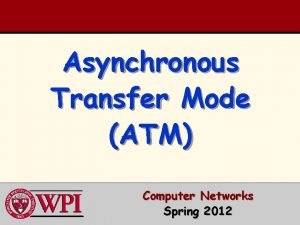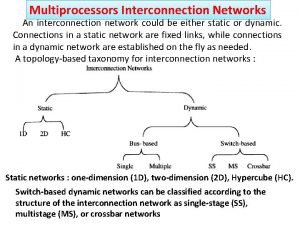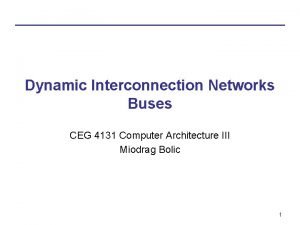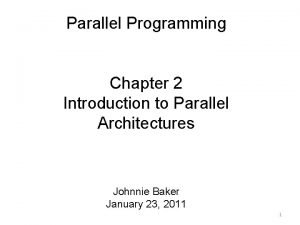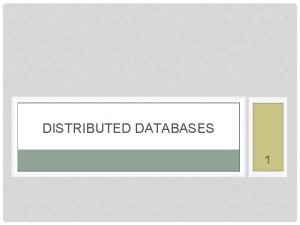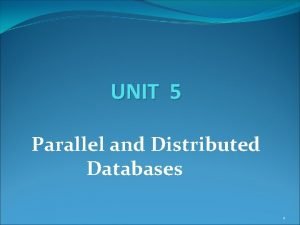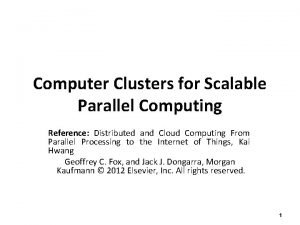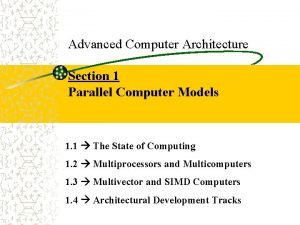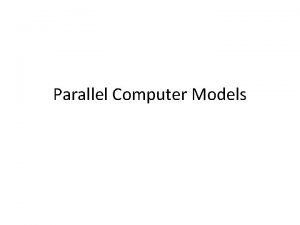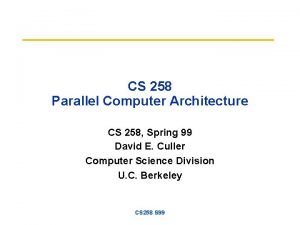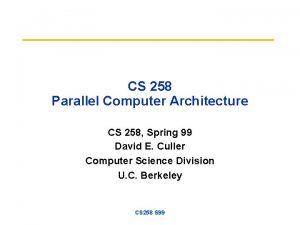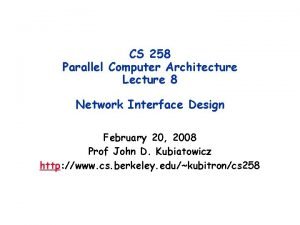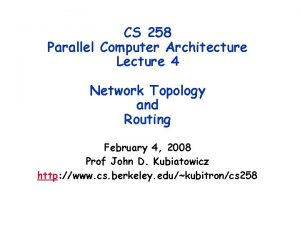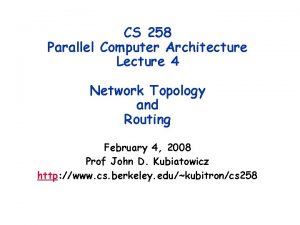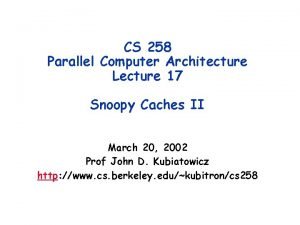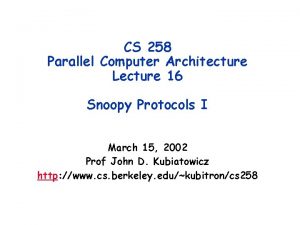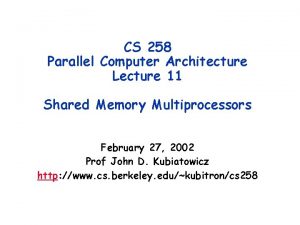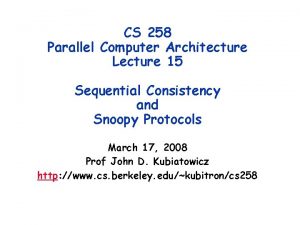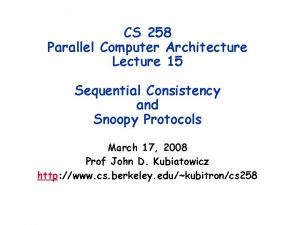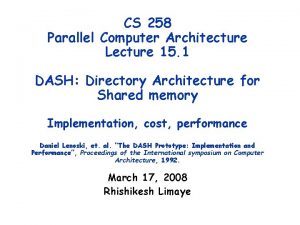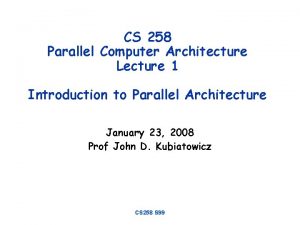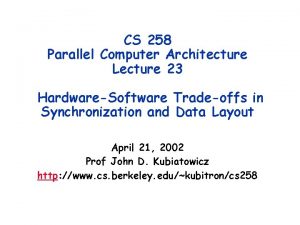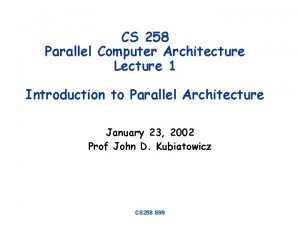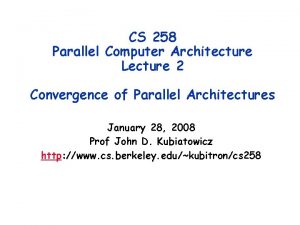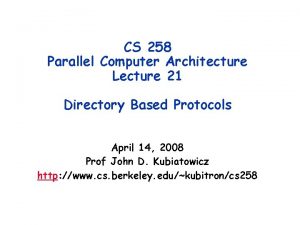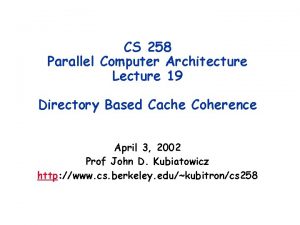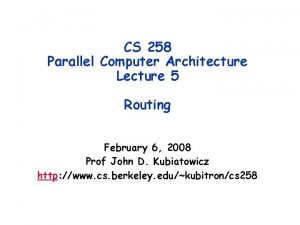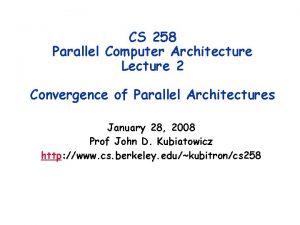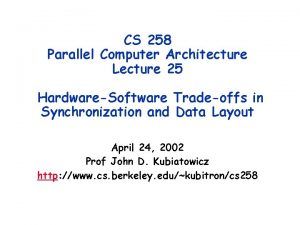CS 258 Parallel Computer Architecture Lecture 4 Network















































- Slides: 47

CS 258 Parallel Computer Architecture Lecture 4 Network Topology and Routing February 1, 2002 Prof John D. Kubiatowicz http: //www. cs. berkeley. edu/~kubitron/cs 258

Review: Links and Channels . . . ABC 123 => . . . QR 67 => Transmitter Receiver • transmitter converts stream of digital symbols into signal that is driven down the link • receiver converts it back – tran/rcv share physical protocol • trans + link + rcv form Channel for digital info flow between switches • link-level protocol segments stream of symbols into larger units: packets or messages (framing) • node-level protocol embeds commands for dest communication assist within packet • Clock synchronization: Synchronous or Asynchronous 2/1/02 2

Review: Store&Forward vs Wormhole Time: h(n/b + D/ ) vs OR(cycles): h(n/w + D) n/b + h D/ vs n/w + h D • Wormhole vs virtual cut-through. 2/1/02 3

Direct vs Indirect • Direct: Every network node associated with processor – Examples: Meshes • Indirect: More Network nodes than processors – Examples: Trees, Butterflies 2/1/02 4

Linear Arrays and Rings • Linear Array – – Diameter? Average Distance? Bisection bandwidth? Route A -> B given by relative address R = B-A • Torus? • Examples: FDDI, SCI, Fiber. Channel Arbitrated Loop, KSR 1 2/1/02 5

Multidimensional Meshes and Tori 2 D Grid 3 D Cube • d-dimensional array – n = kd-1 X. . . X k. O nodes – described by d-vector of coordinates (id-1, . . . , i. O) • d-dimensional k-ary mesh: N = kd – k = dÖN – described by d-vector of radix k coordinate • d-dimensional k-ary torus (or k-ary d-cube)? 2/1/02 6

Embeddings in two dimensions 6 x 3 x 2 • Embed multiple logical dimension in one physical dimension using long wires • When embedding higher-dimension in lower one, either some wires longer than others, or all wires long 2/1/02 7

Trees • Diameter and ave distance logarithmic – k-ary tree, height d = logk N – address specified d-vector of radix k coordinates describing path down from root • Fixed degree • Route up to common ancestor and down – R = B xor A – let i be position of most significant 1 in R, route up i+1 levels – down in direction given by low i+1 bits of B • H-tree space is O(N) with O(ÖN) long wires • Bisection BW? 2/1/02 8

Fat-Trees • Fatter links (really more of them) as you go up, so bisection BW scales with N 2/1/02 9

Butterflies building block 16 node butterfly • • Tree with lots of roots! N log N (actually N/2 x log. N) Exactly one route from any source to any dest R = A xor B, at level i use ‘straight’ edge if ri=0, otherwise cross edge • Bisection N/2 vs n (d-1)/d 2/1/02 10

k-ary d-cubes vs d-ary k-flies • • degree d N switches vs N log N switches diminishing BW per node vs constant requires locality vs little benefit to locality • Can you route all permutations? 2/1/02 11

Benes network and Fat Tree • Back-to-back butterfly can route all permutations • What if you just pick a random mid point? 2/1/02 12

Hypercubes • Also called binary n-cubes. 2 n. • O(log. N) Hops • Good bisection BW • Complexity # of nodes = N = – Out degree is n = log. N correct dimensions in order – with random comm. 2 ports per processor 0 -D 2/1/02 1 -D 2 -D 3 -D 4 -D 5 -D ! 13

Relationship Bttr. Flies to Hypercubes • Wiring is isomorphic • Except that Butterfly always takes log n steps 2/1/02 14

Toplology Summary Topology Degree Diameter Ave Dist Bisection D (D ave) @ P=1024 1 D Array 2 N-1 N/3 1 huge 1 D Ring 2 N/4 2 2 D Mesh 4 2 (N 1/2 - 1) 2/3 N 1/2 63 (21) 2 D Torus 4 N 1/2 2 N 1/2 32 (16) nk/2 nk/4 15 (7. 5) @n=3 n n/2 N/2 k-ary n-cube 2 n Hypercube n =log N 10 (5) • All have some “bad permutations” – many popular permutations are very bad for meshs (transpose) – ramdomness in wiring or routing makes it hard to find a bad one! 2/1/02 15

How Many Dimensions? • n = 2 or n = 3 – Short wires, easy to build – Many hops, low bisection bandwidth – Requires traffic locality • n >= 4 – Harder to build, more wires, longer average length – Fewer hops, better bisection bandwidth – Can handle non-local traffic • k-ary d-cubes provide a consistent framework for comparison – N = kd – scale dimension (d) or nodes per dimension (k) – assume cut-through 2/1/02 16

Traditional Scaling: Latency(P) • Assumes equal channel width – independent of node count or dimension – dominated by average distance 2/1/02 17

Average Distance ave dist = d (k-1)/2 • but, equal channel width is not equal cost! • Higher dimension => more channels 2/1/02 18

In the 3 D world • For n nodes, bisection area is O(n 2/3 ) • For large n, bisection bandwidth is limited to O(n 2/3 ) – Bill Dally, IEEE TPDS, [Dal 90 a] – For fixed bisection bandwidth, low-dimensional k-ary n-cubes are better (otherwise higher is better) – i. e. , a few short fat wires are better than many long thin wires – What about many long fat wires? 2/1/02 19

Equal cost in k-ary n-cubes • • Equal number of nodes? number of pins/wires? bisection bandwidth? area? Equal wire length? What do we know? • switch degree: d diameter = d(k-1) • total links = Nd • pins per node = 2 wd • bisection = kd-1 = N/k links in each directions • 2 Nw/k wires cross the middle 2/1/02 20

Latency(d) for P with Equal Width • total links(N) = Nd 2/1/02 21

Latency with Equal Pin Count • Baseline d=2, has w = 32 (128 wires per node) • fix 2 dw pins => w(d) = 64/d • distance up with d, but channel time down 2/1/02 22

Latency with Equal Bisection Width • N-node hypercube has N bisection links • 2 d torus has 2 N 1/2 • Fixed bisection => w(d) = N 1/d / 2 = k/2 • 1 M nodes, d=2 has w=512! 2/1/02 23

Larger Routing Delay (w/ equal pin) • Dally’s conclusions strongly influenced by assumption of small routing delay 2/1/02 24

Latency under Contention • Optimal packet size? Channel utilization? 2/1/02 25

Saturation • Fatter links shorten queuing delays 2/1/02 26

Phits per cycle • higher degree network has larger available bandwidth – cost? 2/1/02 27

Discussion • Rich set of topological alternatives with deep relationships • Design point depends heavily on cost model – nodes, pins, area, . . . – Wire length or wire delay metrics favor small dimension – Long (pipelined) links increase optimal dimension • Need a consistent framework and analysis to separate opinion from design • Optimal point changes with technology 2/1/02 28

The Routing problem: Local decisions • Routing at each hop: Pick next output port! 2/1/02 29

Routing • Recall: routing algorithm determines – which of the possible paths are used as routes – how the route is determined – R: N x N -> C, which at each switch maps the destination node nd to the next channel on the route • Issues: – Routing mechanism » arithmetic » source-based port select » table driven » general computation – Properties of the routes – Deadlock free 2/1/02 30

Routing Mechanism • need to select output port for each input packet – in a few cycles • Simple arithmetic in regular topologies – ex: » » » Dx, Dy routing west (-x) east (+x) south (-y) north (+y) processor in a grid Dx < 0 Dx > 0 Dx = 0, Dy < 0 Dx = 0, Dy > 0 Dx = 0, Dy = 0 • Reduce relative address of each dimension in order – Dimension-order routing in k-ary d-cubes – e-cube routing in n-cube 2/1/02 31

Routing Mechanism (cont) P 3 P 2 P 1 P 0 • Source-based – – message header carries series of port selects used and stripped en route CRC? Packet Format? CS-2, Myrinet, MIT Artic • Table-driven – message header carried index for next port at next switch » o = R[i] – table also gives index for following hop » o, I’ = R[i ] – ATM, HPPI, MPLS 2/1/02 32

Properties of Routing Algorithms • Deterministic – route determined by (source, dest), not intermediate state (i. e. traffic) • Adaptive – route influenced by traffic along the way • Minimal – only selects shortest paths • Deadlock free – no traffic pattern can lead to a situation where no packets move forward 2/1/02 33

Deadlock Freedom • How can it arise? – necessary conditions: » shared resource » incrementally allocated » non-preemptible – think of a channel as a shared resource that is acquired incrementally » source buffer then dest. buffer » channels along a route • How do you avoid it? – constrain how channel resources are allocated – ex: dimension order • How do you prove that a routing algorithm is deadlock free 2/1/02 34

Proof Technique • resources are logically associated with channels • messages introduce dependences between resources as they move forward • need to articulate the possible dependences that can arise between channels • show that there are no cycles in Channel Dependence Graph – find a numbering of channel resources such that every legal route follows a monotonic sequence • => no traffic pattern can lead to deadlock • network need not be acyclic, on channel dependence graph 2/1/02 35

Example: k-ary 2 D array • Thm: Dimension-ordered (x, y) routing is deadlock free • Numbering – – +x channel (i, y) -> (i+1, y) gets i similarly for -x with 0 as most positive edge +y channel (x, j) -> (x, j+1) gets N+j similary for -y channels • any routing sequence: x direction, turn, y direction is increasing 2/1/02 36

Channel Dependence Graph 2/1/02 37

More examples: • Why is the obvious routing on X deadlock free? – butterfly? – tree? – fat tree? • Any assumptions about routing mechanism? amount of buffering? • What about wormhole routing on a ring? 2 1 0 3 7 4 5 2/1/02 6 38

Deadlock free wormhole networks? • Basic dimension order routing techniques don’t work for k -ary d-cubes – only for k-ary d-arrays (bi-directional) • Idea: add channels! – provide multiple “virtual channels” to break the dependence cycle – good for BW too! – Do not need to add links, or xbar, only buffer resources • This adds nodes the CDG, remove edges? 2/1/02 39

Breaking deadlock with virtual channels 2/1/02 40

Up*-Down* routing • Given any bidirectional network • Construct a spanning tree • Number of the nodes increasing from leaves to roots • UP increase node numbers • Any Source -> Dest by UP*-DOWN* route – up edges, single turn, down edges • Performance? – Some numberings and routes much better than others – interacts with topology in strange ways 2/1/02 41

Turn Restrictions in X, Y • XY routing forbids 4 of 8 turns and leaves no room for adaptive routing • Can you allow more turns and still be deadlock free 2/1/02 42

Minimal turn restrictions in 2 D +y +x -x north-last 2/1/02 -y negative first 43

Example legal west-first routes • Can route around failures or congestion • Can combine turn restrictions with virtual channels 2/1/02 44

Adaptive Routing • R: C x N x S -> C • Essential for fault tolerance – at least multipath • Can improve utilization of the network • Simple deterministic algorithms easily run into bad permutations • fully/partially adaptive, minimal/non-minimal • can introduce complexity or anomolies • little adaptation goes a long way! 2/1/02 45

Summary #1 Topology Degree Diameter Ave Dist Bisection D (D ave) @ P=1024 1 D Array 2 N-1 N/3 1 huge 1 D Ring 2 N/4 2 2 D Mesh 4 2 (N 1/2 - 1) 2/3 N 1/2 63 (21) 2 D Torus 4 N 1/2 2 N 1/2 32 (16) nk/2 nk/4 15 (7. 5) @n=3 n n/2 N/2 k-ary n-cube 2 n Hypercube n =log N 10 (5) • Tradeoffs in cost: – Constant N, Bisection BW, etc? – Unconstrained: higher-dimensional networks better – Constrained, somewhat lower is better 2/1/02 46

Summary #2 • Routing Algorithms restrict the set of routes within the topology – simple mechanism selects turn at each hop – arithmetic, selection, lookup • Deadlock-free if channel dependence graph is acyclic – limit turns to eliminate dependences – add separate channel resources to break dependences – combination of topology, algorithm, and switch design • Deterministic vs adaptive routing – Adaptive adds more freedom, but causes more deadlock 2/1/02 47
 Computer architecture lecture notes
Computer architecture lecture notes Isa definition computer
Isa definition computer 456x203
456x203 Section 258 of mlrc
Section 258 of mlrc Emily dickinson poem 258
Emily dickinson poem 258 The verbs ser and estar (p. 258) answers
The verbs ser and estar (p. 258) answers Via cavour 258 roma
Via cavour 258 roma Rd 258/99
Rd 258/99 Gog 258
Gog 258 01:640:244 lecture notes - lecture 15: plat, idah, farad
01:640:244 lecture notes - lecture 15: plat, idah, farad Synchronization in computer architecture
Synchronization in computer architecture Interrupt in computer architecture
Interrupt in computer architecture Buses in computer architecture
Buses in computer architecture Chordal ring
Chordal ring Dynamic interconnection network in computer architecture
Dynamic interconnection network in computer architecture Atm in data communication
Atm in data communication Network interconnection studies
Network interconnection studies Bus interconnection in computer architecture
Bus interconnection in computer architecture Network topologies
Network topologies Difference between organisation and architecture
Difference between organisation and architecture Design of basic computer
Design of basic computer Cloud computing lecture
Cloud computing lecture Graph neural network lecture
Graph neural network lecture Telecommunication network management lecture notes
Telecommunication network management lecture notes Computer security 161 cryptocurrency lecture
Computer security 161 cryptocurrency lecture Computer-aided drug design lecture notes
Computer-aided drug design lecture notes Like and unlike forces
Like and unlike forces Focal point in fingerprint
Focal point in fingerprint Parallelism
Parallelism Purdue parallel structure
Purdue parallel structure Mary likes hiking swimming and to ride a bicycle
Mary likes hiking swimming and to ride a bicycle Serial in serial out shift register truth table
Serial in serial out shift register truth table What's a parallel sentence
What's a parallel sentence Types of parallel architecture
Types of parallel architecture Parallel and distributed database architecture
Parallel and distributed database architecture Parallel and distributed database architecture
Parallel and distributed database architecture Parallel processing architecture
Parallel processing architecture Series parallel network
Series parallel network Series parallel network
Series parallel network Computer graphics drawing
Computer graphics drawing Design objectives of computer clusters
Design objectives of computer clusters Parallel computer models
Parallel computer models Parallel projection in computer graphics
Parallel projection in computer graphics 1 crore in numbers
1 crore in numbers Architecture business cycle in software architecture
Architecture business cycle in software architecture Return architecture
Return architecture Modular product architectures
Modular product architectures Types of modular architecture
Types of modular architecture



